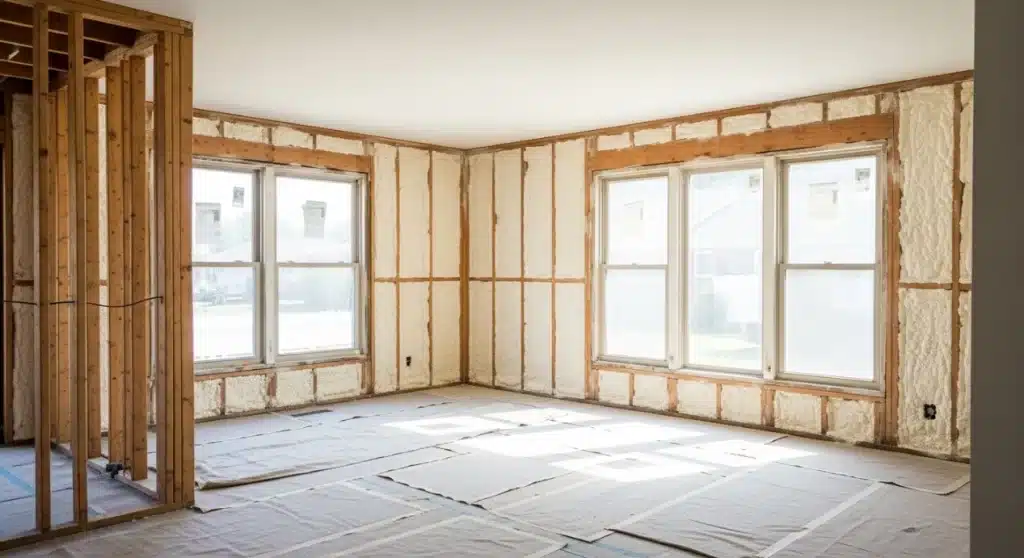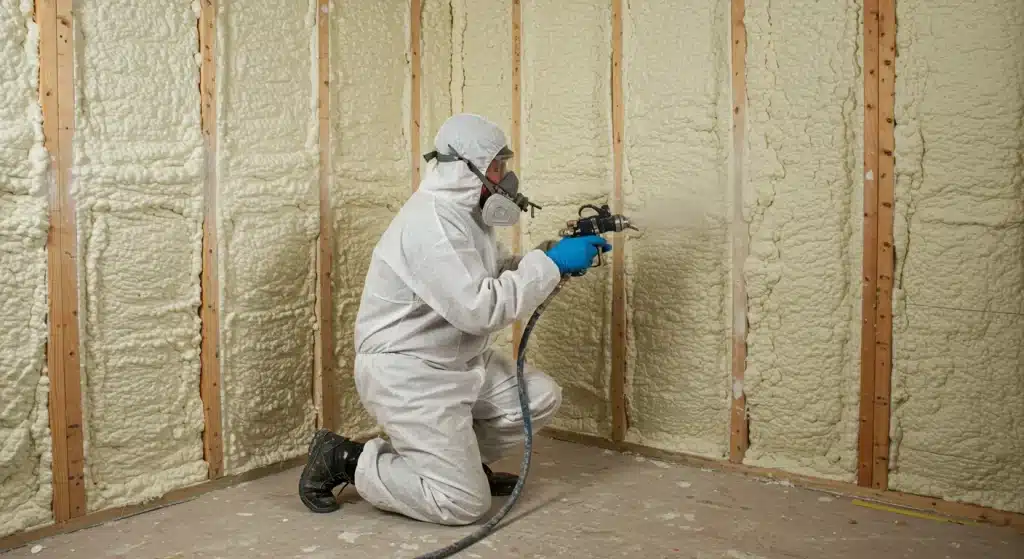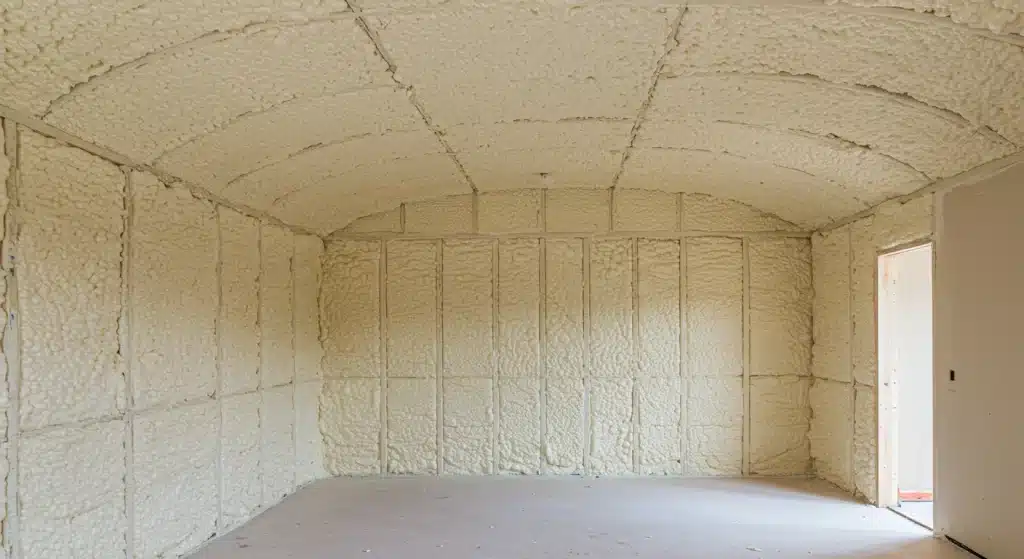Your home’s walls are the primary barrier against the outdoors, but if they rely on outdated insulation, you’re likely losing a significant amount of energy and comfort. Modern insulation solutions address the critical performance gaps left by traditional materials like fiberglass and cellulose. This article focuses on spray polyurethane foam (SPF), a leading example that doesn’t just slow heat transfer; it creates a comprehensive air and moisture barrier. This integrated approach stops drafts, prevents moisture issues, and lowers energy bills by reducing the workload on your heating and cooling systems.
This article breaks down exactly why upgrading your wall insulation is a smart investment. The information here is based on extensive field experience installing and evaluating home insulation performance. You will learn the practical differences between old and new materials, how modern solutions perform in different climates, and what to consider before making a change.
The Shortcomings of Traditional Insulation
For decades, materials like fiberglass batts and blown-in cellulose were the standard for insulating walls. While they offer some thermal resistance, they have inherent weaknesses that become more apparent over time.
Fiberglass batts, which come in pre-cut pink or yellow rolls, are notoriously difficult to install perfectly. Any gap, compression, or void around pipes, wires, and outlets allows air to move freely, creating cold or hot spots on your walls. A study from the Oak Ridge National Laboratory highlights that even small installation imperfections can seriously degrade the performance of batt insulation.
Blown-in cellulose is made from recycled paper products. While it does a better job of filling irregular spaces than batts, it’s susceptible to settling. Over the years, cellulose can compact inside a wall cavity, leaving the top portion of the wall completely uninsulated. Both fiberglass and cellulose can also absorb moisture, which not only reduces their insulating capability but can also lead to mold and rot within the wall structure.
What Makes Modern Insulation Different?
The biggest distinction with modern insulation, like spray polyurethane foam (SPF), is its ability to perform multiple functions at once. Instead of just resisting heat flow, spray foam expands upon application to fill every crack and crevice. This creates a continuous, monolithic seal that is far more effective than simply placing material within a wall cavity.
There are two main types of spray foam used in walls:
- Open-Cell SPF: This type has a softer, more flexible texture. It’s an excellent air barrier and also provides sound-dampening qualities, making it a good choice for interior walls and reducing noise from outside.
- Closed-Cell SPF: This foam is dense and rigid. It offers a higher R-value per inch and acts as a vapor barrier, preventing moisture from passing through. Its structural rigidity can even add strength to the wall assembly. According to the U.S. Department of Energy, this density makes it highly resistant to water.
This air-sealing capability is what truly sets it apart. Air leakage is a major source of energy loss, with information from ENERGY STAR suggesting that homeowners can save an average of 15% on heating and cooling costs just by air sealing and insulating.
Beyond R-Value: A Full Performance Comparison
Understanding the technical differences between insulation types helps clarify why modern solutions offer better long-term value. While the R-value measures resistance to heat flow, it doesn’t tell the whole story. How a material handles air and moisture is just as important for real-world performance.
Material Performance Comparison
| Feature | Fiberglass Batts | Blown-In Cellulose | Closed-Cell Spray Foam |
|---|---|---|---|
| Typical R-Value | R-3.1 to R-3.8 per inch | R-3.2 to R-3.8 per inch | R-6.0 to R-7.0 per inch |
| Air Seal | Poor (allows leakage) | Fair (settles over time) | Excellent (creates a seal) |
| Moisture Resistance | Poor (absorbs water) | Poor (absorbs water) | Excellent (resists water) |
| Lifespan | 10-25 years before degrading | 15-30 years before settling | 80+ years |
| Fills Gaps | No | Partially | Yes, completely |
As the table shows, while the initial R-value of traditional materials seems adequate, their inability to stop air leakage and their vulnerability to moisture mean their effective performance is often much lower.

Practical Benefits in Different Climates
Insulation needs vary depending on your location. A modern solution is uniquely capable of adapting to different environmental demands.
In hot, dry climates like Las Vegas, the primary goal is to keep intense solar heat out of the home. Radiant heat can easily pass through walls, forcing air conditioners to run constantly. Closed-cell spray foam’s high R-value and air-sealing properties create a formidable barrier against this heat transfer. This keeps interior temperatures stable and can dramatically reduce cooling costs during punishing summer months.
Conversely, in cold climates, the main objective is preventing expensive heated air from escaping. Air leaks in walls are a huge source of heat loss. By creating an airtight seal, spray foam keeps the warm air inside, reducing the burden on the furnace and preventing uncomfortable drafts. You can identify these weak spots yourself with a simple test.
Bonus Tip: Before insulating, use a smoke pen or incense stick on a windy day to check for air leaks around window frames and electrical outlets on exterior walls. These are common failure points that modern insulation can permanently seal.
Things to Consider Before Making a Decision
Upgrading your wall insulation is a significant project. Before moving forward, you should evaluate a few key factors to ensure you make the right choice for your home.
- Assess Your Current Situation: Do you have noticeable drafts? Are some rooms much harder to heat or cool than others? Are your energy bills consistently high? These are all signs that your current insulation is underperforming.
- Understand Your Walls: The type of insulation that works best can depend on whether you are building a new home or retrofitting an existing one. For existing homes with drywall in place, injectable foam can be installed with minimal disruption. For new construction or major renovations, two-part spray foam applied directly to the wall sheathing is ideal.
- Cost vs. Long-Term Value: Modern insulation typically has a higher upfront cost than traditional materials. It is important to weigh this against the long-term savings. The improved energy efficiency, increased home comfort, and added durability often provide a return on investment over several years.
- Choosing the Right Foam: The choice between open-cell and closed-cell foam depends on your budget, climate, and goals. Closed-cell is better for areas where moisture is a concern or where the highest possible R-value is needed. Open-cell is a cost-effective air barrier and soundproofer. To ensure you’re making the most effective investment, however, it’s wise to get an expert opinion.
Bonus Tip: Consider getting a professional home energy audit. An audit uses tools like blower doors and infrared cameras to pinpoint exactly where your home is losing the most energy, ensuring your investment is targeted for maximum impact.
Your Next Step: A Professional Assessment
Moving beyond outdated insulation is one of the most effective upgrades for a more comfortable, durable, and energy-efficient home. By controlling heat flow, air movement, and moisture all at once, modern solutions offer a comprehensive approach to performance. The best way to determine your home’s needs is through a detailed evaluation by an experienced professional, who can identify problem areas and recommend the most effective solution for your property. For a thorough consultation, you can contact the team at Supreme Spray Foam LV. Reach out with questions to [email protected] or call (702) 904-9895 to discuss your project.
Sources
- Oak Ridge National Laboratory – A U.S. multiprogram science and technology national laboratory that provides research on building sciences and energy efficiency.
- U.S. Department of Energy – The official government resource for energy-saving information, including detailed guides on different types of insulation materials.
- ENERGY STAR – A U.S. Environmental Protection Agency (EPA) program providing credible, objective information on energy efficiency, including data on savings from air sealing.
Frequently Asked Questions
What is R-value and why does it matter for walls?
R-value measures a material’s ability to resist the flow of heat. The higher the R-value, the better the insulation. For walls, a higher R-value is important because they represent a large surface area of your home. However, R-value only measures one aspect of performance. An insulation with a high R-value but poor air sealing will not perform as well as a lower R-value material that stops air leaks.
How does modern insulation help with noise reduction?
The composition of spray foam insulation makes it an effective sound-dampening material. Open-cell foam, in particular, excels at absorbing sound waves, which can significantly reduce noise from traffic, neighbors, or between rooms in your own home.
Is spray foam insulation safe for my family?
Once cured, modern spray foam insulation is inert and stable. It does not release harmful gases or chemicals into the air. During installation, professional crews use ventilation and personal protective equipment to manage off-gassing while the foam cures, which typically takes about 24 hours.
How long does modern insulation last compared to older types?
Spray foam insulation is a durable material that does not sag, settle, or degrade over time. It adheres directly to the wall structure and maintains its shape and performance for the life of the building. This is a big advantage over fiberglass or cellulose, which can lose effectiveness and may need to be replaced after a few decades.






